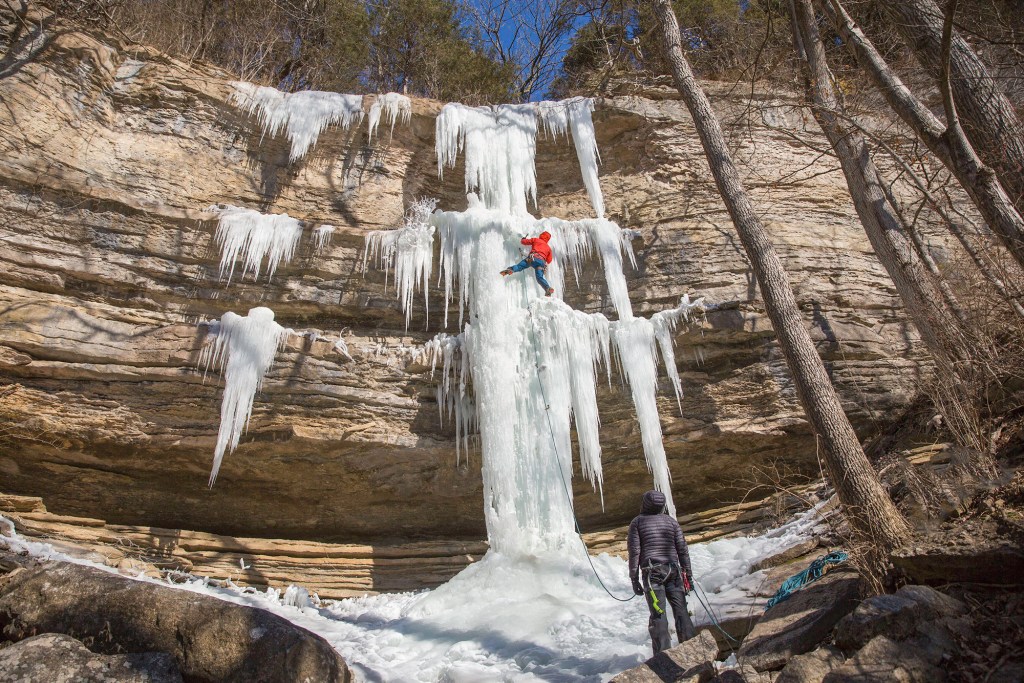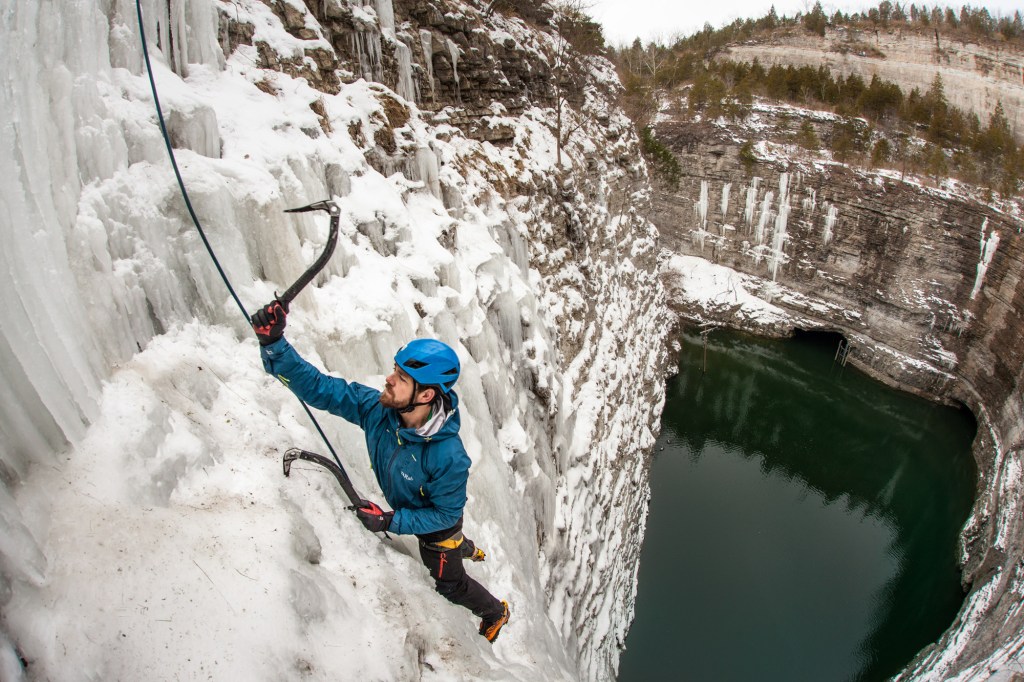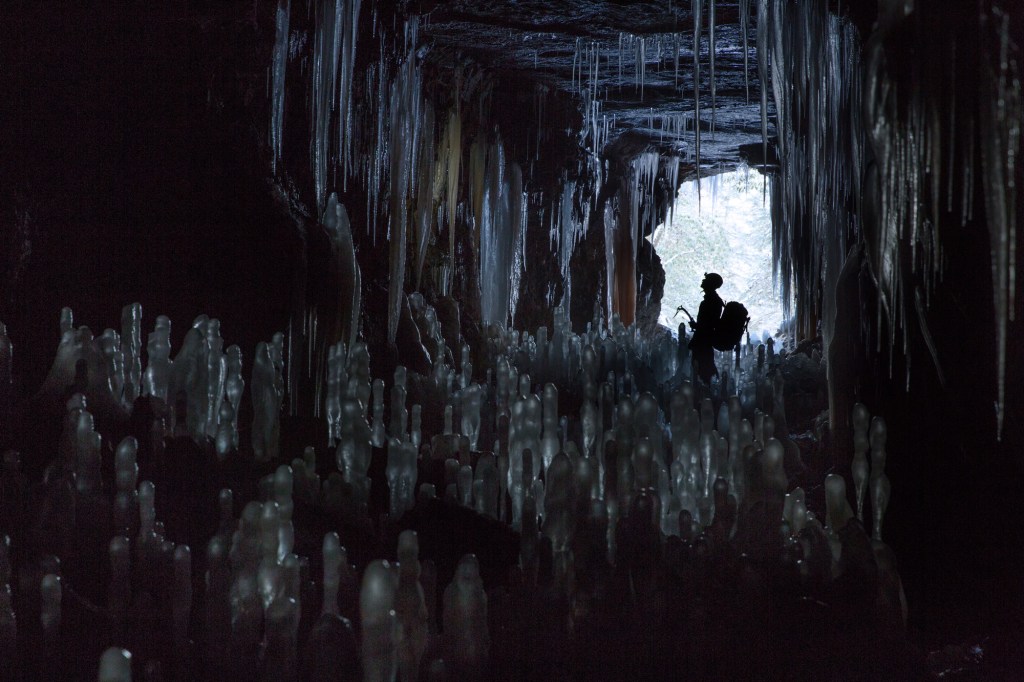Bourbon. Horse racing. Fried chicken. These are a few of the things Kentucky is known for—not its ice climbing. Mild winters with temps hovering right around 50 degrees Fahrenheit frequently mean an absence of ice in the Bluegrass State, though it’s a different story when a sustained cold front sets in. Then, climbers flock to the pillars that freeze inside Red River Gorge and the vertical routes only reached by frigid canoe ride, like the ones on Elkhorn Creek outside Frankfort.
That fleeting splendor is the subject of a new documentary, Gone Tomorrow, from Lexington-based filmmaker Mike Wilkinson, a transplant who moved to Kentucky in 2015 to climb. Here he describes what it was like to capture the state’s ice climbing scene on film.
The following interview has been edited and condensed for clarity.
Did you grow up in Kentucky?
No, I grew up in Michigan and moved to Kentucky in 2015 for the climbing. My partner, Jennifer, and I had spent a couple of years out West, but we’d take all our vacations in Kentucky climbing, so we decided to move here. My favorite thing to do is go bushwhacking into the northern part of the Red River Gorge and find new potential trad routes. When I moved here, I knew there was a ton of rock that hadn’t been discovered yet, but I was surprised to find ice, too.
You probably aren’t alone; most people will be surprised at the kind of ice you’re climbing in your film.
Definitely. When I got into Kentucky, I had heard from a buddy that there was this mythical ice here, so I linked up with a friend of a friend and joined a small group of climbers. I knew right away that the ice was special.
What makes the ice in Kentucky so special?
The fact that you wouldn’t expect it to be here and it’s fleeting. Michigan will have ice for five months. Even in the warm years, there’s ice to climb. Here in Kentucky, there are years we don’t have ice at all. That elusive nature of finding enough ice to climb makes it so special.

How many people are actually climbing ice in Kentucky?
Not many. No more than 10 people I’d guess, and half are buddies of mine. On the coldest day of a cold winter, on the most obvious ice climb in Kentucky, six or seven people might show up. You can’t even buy ice climbing equipment at a gear shop here.
But according to Gone Tomorrow, there is a history of ice climbing in Kentucky.
A major part of the film was researching the people who were climbing ice here in the ’70s and ’80s. They were total badasses and climbing with the worst gear imaginable. The photos they shared were so cool—it’s crazy because we’ve seen some those ice lines trying to form, but it has never gotten cold enough to make it happen. In the ’70s, they had a bunch of snow and one winter, school was closed for a month. I don’t think conditions that good have existed since then. And they might never exist again.
So, where is the good ice when it’s cold enough?
The obvious stuff would be in the Red River Gorge. That’s the easier-to-find stuff—these beautiful pillars from waterfalls—but it takes a lot of really cold weather for that stuff to set up. Then there’s stuff outside of the gorge that’s harder to find, but more reliable because it doesn’t take as long to freeze. There’s water oozing over road cuts turning to ice on state highways, and a quarry that has 120-foot long routes, some of them are over open water. It’s beautiful.

Is the footage in your film from a single ice climbing season?
It took me three or four seasons to film it, but most of the good climbing footage came from the 2017-18 season. That was a cold winter. We had two weeks that were so cold, the pillars in the Red River Gorge froze. There was stuff to climb we’d never seen before. But it hasn’t been that cold since. I haven’t climbed more than two days this winter.
Are you concerned about the impact of climate change in a place like Kentucky where the winters are already warm?
I absolutely worry about the impacts of climate change when it comes to future ice seasons in Kentucky. That’s why I honestly wonder if we might not ever see the same ice from the ’70s again. Perhaps with climate change we might seem some weather oddities, with more swings of hot and cold, and we get an awesome winter in a few years? All we can do is watch the forecast and keep our picks sharp.
I’m guessing when the ice is in, you’re probably not sitting in your office editing film.
When it comes in, I drop everything. That’s the nature of ice climbing here. It’s all in the title of the film, Gone Tomorrow. You have to seize the moment. There are climbs we’ve led that we’ve never seen before and we might never see them again. It’s now or never.

So how much potential is out there if the temperature drops?
There’s a lot of ice out there. We’ve climbed the obvious stuff—the tourist waterfalls and oozes of ice you can see from the road. A lot of that stuff has been done. On cold winters, after we get our fix on the obvious stuff, that’s when we go into the woods and start exploring. We’re finding big waterfalls that aren’t on maps. Zones where there are 300-foot limestone bowls on the Kentucky River that freeze up. We have pins on maps and we’re just waiting for that stuff to freeze up.
What should people do if they’re interested in climbing ice in Kentucky?
It’s really not a developed activity here, so your best bet is to watch the forecast and then reach out to locals such as myself for beta. Kentucky Rock and Adventure Guides would be the guide service and first point of contact for anyone who’s curious.
Gone Tomorrow is making its way through the adventure film festival circuit in 2020 and was recently accepted into the Banff Mountain Film Festival World Tour, one of only 25 documentaries to earn that honor. Screenings will take place across the U.S., including at the following festivals:
- Auburn Adventure Film Festival: February 22
- Vancouver International Film Festival: February 28
- Boulder International Film Festival: March 7
- Sheffield Adventure Film Festival: March 20–21
- Wasatch Mountain Film Festival: March 30
See the film’s website for a full list of festivals and screenings.
All photos by Mike Wilkinson.
